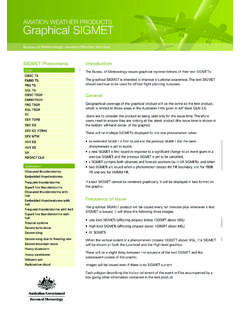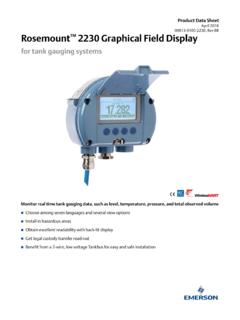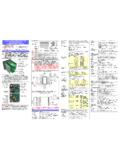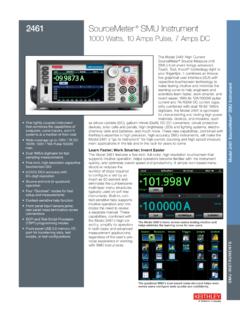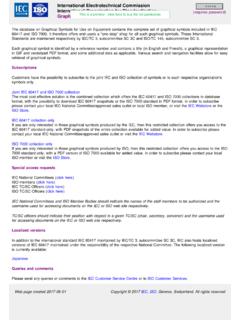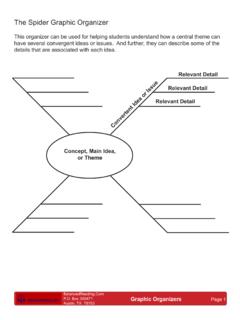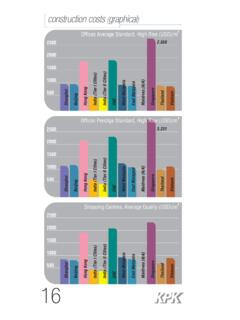Transcription of Chapter 2 Graphical methods for presenting data
1 Chapter 2 Graphical methods for presenting IntroductionWe have looked at ways of collecting data and then collating them into tables. Frequency tablesare useful methods of presenting data ; they do, however, have their limitations. With largeamounts of data Graphical presentation methods are often clearer to understand. Here, we lookat methods for producing Graphical representations of dataof the types we have seen Stem and Leaf plotsStem and leaf plotsare a quick and easy way of representing data graphically. They can beused with both discrete and continuous data . The method for creating a stem and leaf plot issimilar to that for creating a grouped frequency table.
2 The first stage, as with grouped frequencytables, is to decide on a reasonable number of intervals which span the range of data . The in-terval widths for a stem and leaf plot must be equal. Because of the way the plot works it isbest to use sensible values for the interval width 5,10, 100, 1000; if a dataset consistsof many small values, this interval width could also be 1, or even or Once we havedecided on our intervals we can construct the stem and leaf plot. This is perhaps best describedby the following data :11,12,9,15,21,25,19,8. The first step is to decide on intervalwidths one obvious choice would be to go up in10s.
3 This would give astem unitof 10 and aleaf unitof1. The stem and leaf plot is constructed as 911 2 5 921 5 Stem Leafn= 8, stem unit= 10, leaf unit= can clearly see where the data have been put. The stem units are to the left of the verticalline, while the leaves are to the right. So, for example, our first observation 11 is made up of12 Chapter 2. Graphical methods FOR presenting DATA13a stem unit of one 10 and a leaf unit one 1. It is important to give an equal amount of space toeach leaf value by doing so, we can get a clear picture of any patterns in the data (it s almostlike a bar chart on its side but it still shows the raw observations!)
4 Before producing a stemand leaf plot, it will probably help to first write down the data in ascending numerical 1: Percentage returns on a shareAs you might imagine, the interval width does not have to be 10. The following numbers showthe percentage returns on an ordinary share for 23 consecutive months: , the largest value is and the smallest , and we have lots of decimal values inbetween. Thus, it seems sensible here to have a stem unit of 1 and a leaf unit of A stem andleaf diagram for this set of returns then might look like: 21 3 12 3 2 02 5 6 1 401 9 5 1 3 5 910 5 2 724 4 Stem Leafn= 23, stem unit= 1, leaf unit= 2: Unemployment rates in the , that should all seem fine so far.
5 So what can go wrong? Consider the following data ,which are the percentage unemployment rates for 10 states:17 18 15 14 12 19 20 21 24 15If you were to choose 10 as the interval width ( go up in 10s), the stem and leaf plot wouldlook like12 4 5 5 7 8 920 1 4 Stem Leafn= 10, stem unit= 10, leaf unit= , the interval width is too large, resulting in only two intervals for our data . With such fewintervals it is difficult to identify any patterns in the data . We can get a better idea about what isgoing on if we choose a smaller interval width say 5. Doing sogives the following stem andleaf plot: Chapter 2.
6 Graphical methods FOR presenting DATA1412 415 5 7 8 920 1 4 Stem Leafn= 10, stem unit= 10, leaf unit= now that there are two 1s in the stem one for observations between 10 and 14 (inclusive)and another for observations between 15 and 19 (inclusive).Thus, the stem unit is still 10, butthe interval width is now only 5. Changing the interval widthlike this produces a plot whichstarts to show some sort of pattern in the data indeed, this is the intention of such graphicalpresentations. We could, however, go to the other extreme and havetoo manyintervals. Ifthis were the case, any pattern would again be lost because lots of intervals would contain noobservations at all.
7 So choose your interval width carefully!Example 3: Call centre dataLet s work through the following example. The observationsin the table below are the recordedtime it takes to get through to an operator at a telephone callcentre (in seconds).54 56 50 67 55 38 49 45 39 5045 51 47 53 29 42 44 61 51 5030 39 65 54 44 54 72 65 58 62 Stem Leafn=stem unit=leaf unit= Chapter 2. Graphical methods FOR presenting DATA15 Example 4: Production line dataIf there is more than one significant figure in the data , the extra digits arecut(or truncated), notrounded, to the nearest value; that is to say, , To illustrate this,consider the following data on lengths of items on a production line (in cm) stem and leaf plot for this is as follows:1920 2 325 6 930 438n= 10,stem unit= 1cm, leaf unit= the interval width This allows for greater clarity in the plot.
8 Why do you thinkwecutthe extra digits?Example 5: student marksThe stem and leaf plot below represents the marks on a test for50 7 7 9 920 0 1 1 1 2 2 4 4 4 5 7 7 8 8 832 3 3 3 4 5 5 6 7 7 8 8 9 9 940 0 1 2 2 3 3 4 4 550 0 0n= 50,stem unit= 10, leaf unit= s easy to see some of the advantages of graphically presenting data . For example, here youcan clearly see that the data are centred around a value in thelow 30 s and fall away on eitherside. From stem and leaf plots we can quickly and easily tell if the distribution of the datais symmetric or asymmetric.
9 We can see whether there are anyoutliers, that is, observationswhich are either much larger or much smaller than is typical of the data . We could perhaps eventell whether the data aremulti modal, that is to say, whether there are two or more peaks onthe graph with a gap between them. If so, this could suggest that the sample contains data fromtwo or more 2. Graphical methods FOR presenting Using MinitabWith the small data sets we have seen so far, it is obviously relatively easy to create stem andleaf plots by hand. With larger data sets this would be more problematic and certainly moretime consuming.
10 Fortunately, there are computer packages that will create these plots for us Minitabis one such package, and can be found on most university and guidance on usingMinitabwill be provided in the computer practical sessions inweek Bar ChartsBar chartsare a commonly used and clear way of presenting categoricaldata or any ungroupeddiscrete frequency example, recall the example on students modes of transport:StudentModeStudentModeStudentM ode1 Car11 Walk21 Walk2 Walk12 Walk22 Metro3 Car13 Metro23 Car4 Walk14 Bus24 Car5 Bus15 Train25 Car6 Metro16 Bike26 Bus7 Car17 Bus27 Car8 Bike18 Bike28 Walk9 Walk19 Bike29 Car10 Car20 Metro30 CarThe first logical step is to put these into a frequency table, givingModeFrequencyCar10 Walk7 Bike4 Bus4 Metro4 Train1 Total30 Chapter 2.











